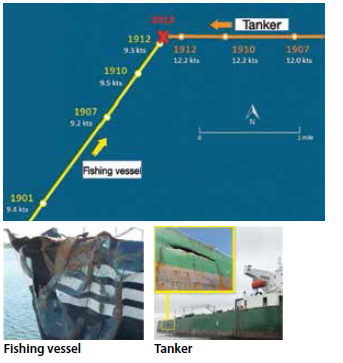201980 Collision in plain sight
Edited from NTSB (USA) Marine Accident Brief DCA18FM023
A partially loaded tanker was underway at about 12 knots in asafety fairway. An OOW and lookout were on duty and the helm was on
autopilot. Daylight was beginning to fade but night had not yet fallen. Ahead and to port the two bridge team members saw a fishing boat coming in their direction. Both believed, from visual observations, that it would pass astern. The Master and the second mate were also on the bridge but were working on ship’s business on computers.
At one point the chief engineer came to the bridge to talk to the Master. As he looked out of the window he saw the fishing vessel at
very close range. His exclamation caught the Master’s attention and the Master left the work station to see the fishing vessel for himself. He immediately ordered hand steering and starboard helm as well as the sounding of the ship’s whistle. Meanwhile on the fishing boat, the lone watchkeeper had been cleaning when he heard a metallic sound, which turned out to be the first contact of the fishing vessel’s outriggers with the side of the tanker. He tried to turn the vessel but it was too late and it made heavy contact
with the tanker.

Lessons learned
- Many collisions can be attributed to ineffective lookout and low situational awareness. This accident is yet another example.
- Never assume the give-way vessel will pass ahead or astern; plot the targets and follow the situation until all clear.
- Undertaking other duties that distract from your navigation responsibilities, as on the fishing vessel in this instance, is a recipe for an accident.
